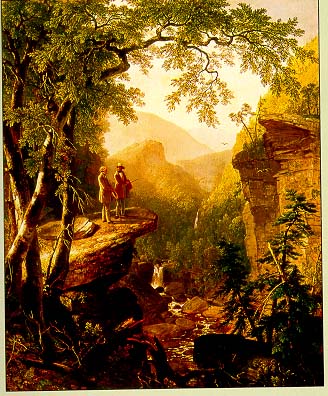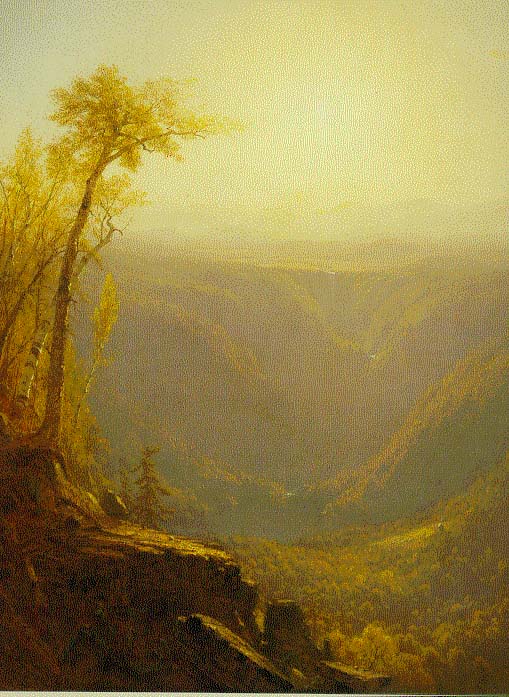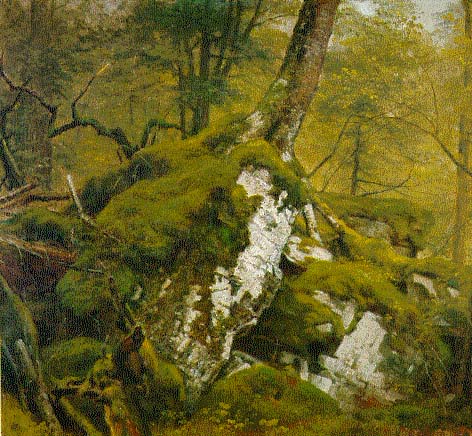|
American Landscape Painting:
The Hudson River School
|
A native movement with ties to European Romanticism,
the so-called Hudson River School was America's first and most influential
school of landscape painting. Though in a sense founded by Thomas Cole
in 1825, the Hudson movement was not strictly speaking a school, but rather
a loose confederation of original artists, disciples, and protégés
united by a common philosophy and style.
Cole was the central figure--both the originator
of the Hudson style and the model for its later imitation and dissemination.
Contrary to Bryant's assumption, the painter was not a native-born American
but a transplanted Englishman, an imaginative nature lover who deserted
the coal fields of his birthplace and sailed across the Atlantic, lured
on by descriptions of an idyllic woodland named Ohio.
No native-born Yankee or true son of '76 could
have loved his new continent more dearly. Cole responded to the American
landscape with the ardor of a newlywed and immediately set to work to capture
its essence (which he recognized as a certain glorious and prolific wildness)
in oil on canvas. By 1825 he was already assembling the main elements and
details of a style that would guide and inspire U.S. landscape painting
for the next fifty years.
Among the many features of that style the following
characteristics seem especially noteworthy:
-
Vastness and Sublimity. Perhaps the first thing that strikes the
viewer of a Cole landscape is a sense of Nature's overwhelming magnitude.
The engulfing scene diminishes its few tiny inhabitants (figures who, far
from being the main subject of the painting, seem to have been inserted
into the landscape purely to provide a sense of scale). The overall effect
is that of an exalted sublimity (that feeling of aesthetic
excitement which, according to Kant, results from the perception of magnitude
plus a sense of risk or danger).
-
Solitude. The quintessential Cole landscape is a pure wilderness,
a natural vista devoid (in Bryant's phrase) of "the trace of men." At times
the Hudson painters would trek for miles into a woods or among the mountains
looking for the perfect spot--ideally a place that had never been viewed,
much less painted, by a person of European descent. The bliss of solitude--the
inner joy of isolated communion with nature--as recommended by Rousseau
and Wordsworth and later by Bryant, Emerson, and Thoreau finds its full
visual expression in the paintings of Cole, Church, Durand, and Bierstadt.
-
Jaggedness and Irregularity. The Hudson River artists sought to
render a raw, wild, untamed nature, a distinctly non-idealized nature.
No dainty scenes of lawns, gardens, soft breezes, and limpid brooks for
them. In place of the orderly spaces, perfectly symmetrical trees, and
balanced compositions of neo-classical tradition, they introduced deliberate
disharmonies and jagged effects: blasted trees, fallen limbs, and naturally
eroded hillsides and riverbanks.
-
Hidden Force. A scene by Cole or Church typically conveys a sense
of concealed dyamism, of submerged or underlying power. Dark clouds or
stormy skies above, uprooted trees and jutting rocks below express the
view that, far from being a serene or static environment, nature is instead
a living, changing, vitalistic force. (See especially Durand's Interior
of a Wood, with its powerful outcroppings, and Church's The
Icebergs, with its eerie atmosphere of beauty and menace.)
-
Luminosity and Shadow. Whether condensed and restricted to a few
spectral rays or flooding in full, incandescent refulgence, light is everpresent
in a Hudson School landscape and represents one of the clear hallmarks
of its style. The light is typically soft and radiant--so much so that,
instinctively, many viewers interpret it as holy, as if it were the visible
sign of a beneficent Deity, the shining signature of nature's own Artist-Creator.
-
Pantheism and Cosmic Optimism. Though Hudson River paintings are
by no means uniformly buoyant and cheerful, and though they often seem
to stress nature's vulnerability (especially to the depradations of industrial
society and the march of civilization), nevertheless most viewers find
in them a sense of hope and endurance as well as a feeling of peacefulness
and affirmation.
Related
Websites

Click
here for further information on Hudson River School
Click
here for a virtual gallery tour 